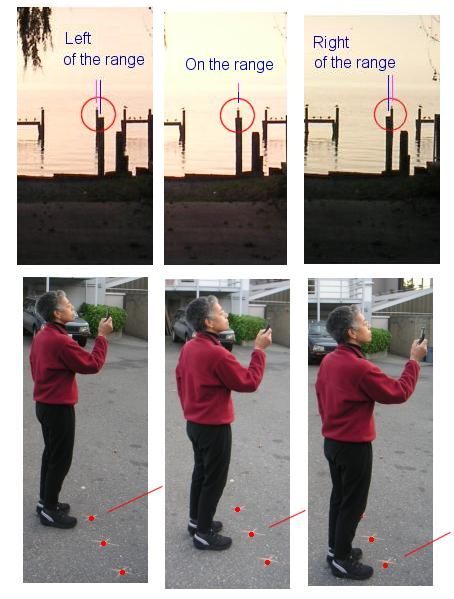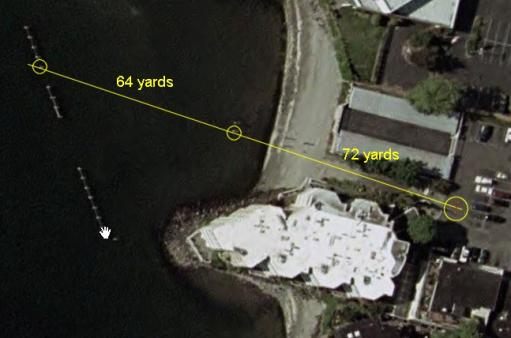A natural range is the alignment of any two objects we see on the waterway. When they are in line, we know we are on the same line. It is an excellent way to see if we are being set by current, or if the objects are actually on the chart, it is the most precise type of line of position we can hope for. The use of navigational ranges (those put there by some agency to help guide us) and natural ranges are discussed in the text book.
The human eye is very sensitive to fine alignments, as shown in the figure below. Vena is using her cell phone camera to take a picture of the alignment of two dolphins in the water at the end of the driveway. There are three pictures, taken about 18 inches either side of precise alignment. Note that the offset from the range is clearly visible even from this very small offset from the actual range.

The
location of the exercise is shown below from a Google Earth capture of
the location. The pictures were taken from the 3 locations shown marked
on the ground in the picture above.

She
was standing at the location of the circle on the far right. The next
circle out is the closest dolphin, and the next is the farthest. This
exercise is meant to show how sensitive the eye is for this observation.
We can easily put numbers on the angles using the
small-angle formula we use throughout our textbook. Namely that a 6-degree
right triangle has sides in the ratio of 1 to 10, and the formula scales accurately to as small as you like. Three degrees has sides in
proportion of 1 to 20, and 1° would have sides of 1 to 60. Thus at 64+72
= 134 yards = 402 feet, a 1° angle would correspond to 402/60 = 6.7
feet off the line. We are only stepping about 1.5 feet, so we are seeing
an angular offset of way less than 1° — more like (1.5/6.7) or about
0.22° or 13' of angle.
So if you do want to estimate how well you can
stay on any range, it is likely fair to assume that you can detect an
offset of about a quarter of a degree, which would be sides in a ratio
of about 1 to 240.
Thus if i am on a range with
markers about 0.5 miles away, i would easily detect when i have drifted
off by about (0.5 x 6000)/240 = 12 feet. Next time you note you are on a
nice natural range or navigational entrance range, take a look to your
GPS positions to monitor how far off you can be before you detect it. If
you are accumulating a trail with the GPS on an echart, then you can
see this nicely by just zooming way in as you alter course back and
forth across the range—by just a little bit.
No comments:
Post a Comment